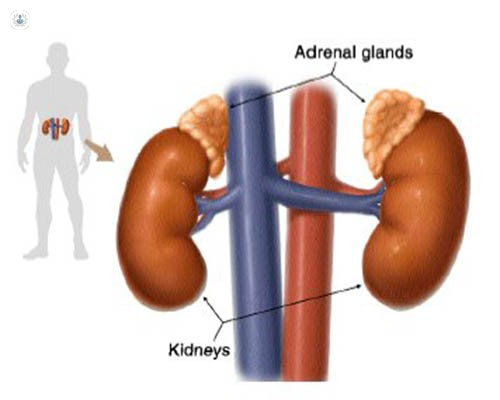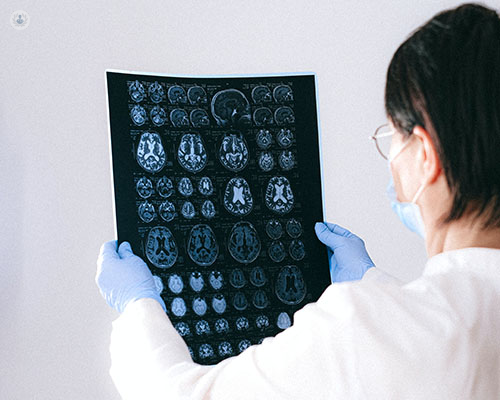Adrenal gland disorders
Dr Helen Spoudeas - Paediatric endocrinology, diabetes & metabolism
Created on: 11-13-2012
Updated on: 06-26-2023
Edited by: Aoife Maguire
What are adrenal gland disorders?
Adrenal gland disorders are a group of conditions affecting the adrenal glands, which are endocrine glands located above the kidneys. These glands are responsible for producing a variety of hormones, which include adrenaline, steroid hormones such as androgens, and corticosteroids. These hormones help the body to control blood sugar, react to stress (e.g injury/illness), regulate blood pressure, and burn fat. Thus, if the adrenal glands are dysfunctional, this can result in an endocrine condition.
There are various types of adrenal gland disorder, including
- cushing’s syndrome
- addison’s disease
- adrenal gland tumours
- hereditary disorders.
- congenital adrenal hyperplasia (CAH)
- adrenal gland cancer
- pheochromocytoma

What causes adrenal gland disorders?
Adrenal gland disorders may occur for several reasons. In many disorders, hormone production is either too little or too high, causing an insufficiency or an abnormal abundance. Adrenal gland disorders can be a result of the following:
- Tumours
- Infection
- Particular types of medication
- Hereditary conditions/genetic mutation
- A problem in another of the body’s endocrine glands, e.g. the pituitary glands
What are the symptoms?
As there are various types of adrenal gland disorders, symptoms will vary depending on the condition.
Cushing's Syndrome
- upper body obesity
- high blood pressure
- weakness in the muscles and in the bones
- high blood sugar levels,
- skin conditions such as acne or marks/streaks on the abdomen
- slow growth rates (in children)
- irritability or depression.
Addison’s Disease
- weight loss
- fatigue
- low blood pressure
- salt cravings
- feeling dizzy when standing up
- nausea or vomiting
- feeling weak
- noticing patches of dark(er) skin
- depression
Congential adrenal hyperplasia symptoms can be mild or more serious, and symptoms may even be so mild that they do not cause the individual problems.
Symptoms of mild CAH
- early signs of puberty
- acne
- irregular periods
- excess facial hair in women
- a shorter than average final height (in younger adults)
Symptoms of more serious or severe CAH
- low blood pressure
- low blood sugars
- difficulty retaining salt in the body
- excess facial hair in women
- benign testicular tumours in men, infertility in men
- abnormal development of the external genitalia in girls
- difficulty becoming pregnant
Pheochromocytoma symptoms include
- excessive sweating
- rapid heartbeat (tachycardia)
- headaches
- high blood pressure (hypertension)
- pale skin, especially on the face
- nausea
- vomiting
- anxiety or panic attacks
Are adrenal tumours common?
Adrenal tumours are quite common. 2-3% of adults experience adrenal tumours in their life. There are certain hormones that are dangerous if overproduced by the tumour. These hormones are aldosterone, cortisol and catecholamines (also known as epinephrine and norepinephrine; adrenaline) and sex-steroid hormones (androgens and estrogens).
If the tumour produces too many of these hormones, then it is referred to as ´fuctional´, due to its overfunctioning nature; it is producing too many hormones.
Functioning adrenal tumours must be removed because excess of these hormones is considered to be toxic and causes damage to the body.
Some tumours do not produce hormones, but damage the pituitary and do not allow it to secrete the right level of hormones. As a result, the adrenal glands will not function as they should.
How are adrenal gland disorders diagnosed?
There are various ways in which adrenal gland disorders can be diagnosed. Some tests which doctors may use to test hormone levels are:
- blood tests, which measure how well the body produces cortisol
- tests to mesasure insulin tolerance
- urine tests
- saliva tests
Doctors may also look for tumours via:
- X-ray
- CT scan
- MRI scan
- MIBG (meta-iodobenzylguanidine) scan (for pheochromocytoma)

What is the treatment?
Treatment depends on the adrenal gland disorder affecting the individual, but generally treatment will be surgical or medical. Treatments include:
- Medication which seeks to stop excess production of hormones
- Hormone replacement medication/therapy
- Tumour removal surgery
- Surgery to remove one or both of the adrenal glands
- Surgery to remove tumours of the pituitary gland
Can you live without adrenal glands?
Yes, it is possible to live without adrenal glands.
Sometimes adrenal glands must be removed because they release too much or too little hormones, signifying that they aren’t working correctly. The procedure to remove adrenal glands is called an adrenalectomy.
Usually, only one of the adrenal glands is removed through surgery and the other adrenal gland replaces the function of the one which was removed. If one of the glands was removed due to overproduction of one hormone then hormone replacement therapy may be necessary in a temporary manner, until the other adrenal gland begins to function correctly again.
However, in some cases, both glands are removed. If this is the case, it is essential to take hormone replacement therapy for the rest of your life.
How you feel after adrenalectomy surgery depends on the reason why the adrenal glands were removed. Returning to a normal diet and activity level quickly is safe. It is recommended to do some light exercise, such as walking to aid the recovery process. Recovery from an adrenalectomy normally takes two to four weeks.
















